

July 3, 2008
Calm has settled on us. After the two days of Tropical Storm Douglas, the ocean is still pushing in big waves, but the ocean height has receded to near normal and the offshore rocks are once again visible above the ocean. It is bright day with scattered large clouds; an unusually beautiful day, with a blue tinge to everything (check out the photos). The air is sparkling clear, glistening with the blueness of the sky and ocean reflected all through the atmosphere. As I look around, everything is not the same; it is clear that the beach has taken the brunt of the storm: What was once a rolling, undulating beach, with four distinct levels, is changed. The constant pounding of the big waves, combined with the high water, washed away the undulating portion of the beach and the flat area above it, creating a long, wide, flat beach. Unbelievable!
Calm has settled on us. After the two days of Tropical Storm Douglas, the ocean is still pushing in big waves, but the ocean height has receded to near normal and the offshore rocks are once again visible above the ocean. It is bright day with scattered large clouds; an unusually beautiful day, with a blue tinge to everything (check out the photos). The air is sparkling clear, glistening with the blueness of the sky and ocean reflected all through the atmosphere. As I look around, everything is not the same; it is clear that the beach has taken the brunt of the storm: What was once a rolling, undulating beach, with four distinct levels, is changed. The constant pounding of the big waves, combined with the high water, washed away the undulating portion of the beach and the flat area above it, creating a long, wide, flat beach. Unbelievable!


The vegetation seems unchanged, but trees were knocked down and snags (dead trees) were also felled. The animals seem to have fared well; we did not find dead birds, or washed up fish or other sea life. The sea life and other wildlife all seem to have their own unique way of coping with the storm. The rain did a great deal of good, except where it flooded in pueblos and cities, recharging the dry, rock-hard soils, which were so dry that the rivers hardly rose after the many inches of rain that fell. Most of the rain soaked into the ground.
July 4, 2008
A pleasant consequence of the rains was that we got to observe the annual march of the land crab! The mollos or moyos (local name for the land crab) are a large, some measuring over 5” in diameter, strange, and beautiful creature. With their blue carapace, red legs with long, dark hair-like spines, and one giant claw, the other is relatively small, they look like colorful miniature tanks slowly rolling along. Walking with a slow determined purpose, marching to a special, secret place, only they know of. This continuous march lasted for two days, with the first day having the most crabs. People came out in large family groups gathering along the highway collecting buckets and bags of the large crabs. Moyos, are delicious and have quite a bit of meat on them. Our friends, Josuel and Adriena, brought us a Tupperware container full of moyos, which we ate hesitantly at first, but devoured them after we learned how good they tasted. That’s it for this year; we’ll have to wait until next year for their return.


Moyos start their journey in the adjacent forested hill, making a long and dangerous trek to the ocean. As you can imagine, crossing roads is their most difficult part of their trip. After mating, the female spends four months in her burrow in gestation. When conditions are right, heavy rain and the highest tide of the month, they emerge out of their burrows and begin their journey. They need the high tide, with a long wash of water up the beach, so they can lay their eggs in the water without getting washed out. They come out by the millions all along the coast of Jalisco, and they were all over our beach, by the hundreds, crawling everywhere, in groups of 5, 10, 20, all walking away from the ocean towards the laguna (lagoon).
July 11, 2008
Beach slowly re-heals
The beach is beginning to heal after the pounding of Tropical Storm Douglas. No longer is it a long, flat beach, but now the waves have created a step drop-off where they crash, as existed before the storm. The steep drop-off has started the reformation of the undulating dunes that was a major characteristic of our beach.
Not long after writing the above note, we were pounded for two days with giant waves from hurricane Bertha. At the closest it was 260 miles west of Manzanillo. Once again the beach is wide and flat. During the summer, this beach is evidently very dynamic, changing constantly under the battering from off-shore storms. I would hate to see one of these storms come on shore!
July 14, 2008
Summer Rains
Spring is here in Tenacatita. It may feel like summer but the trees, shrubs, and herbaceous plants are just now starting to green up. The rains from the big storm and several other thunderstorms have produced a flush of life, with plants coming to life creating a lush green carpet covering the mountains, hillsides, and pastures. It seems to have happened overnight, hillsides that were dry brush and leafless trees have changed to dense green, impenetrable jungle. Many trees and other plants are blooming, which delightfully brings out many beautiful, multi-sized and –colored butterflies. Summer, with its life giving rain, so quickly created on our hillsides a natural garden of blossoming plants, filled with an array of colorful breeding birds and insect life.
The summer rains brought us the march of the Moyos , a serendipitous, totally fascinating experience. Now we excitedly (or fearfully) wait for the march of the tarantulas, which we are told will happen this summer. The summer rains are a constant here in Tenacatita, and it is a joyful event as is seen in the attitudes of the local people who do not let the rain stop their daily routines, and by the myriad adaptations of plants and animals to the cycles of the rain. The winter months here in Tenacatita are beautiful, with mild warm weather, but the intensity and diversity of life found in this place is only fully expressed with the summer rains.
July 15, 2008
Summer is a Poor Fishing Season
Fishing has been very, very slow. Water conditions seem fine to me, but I have seen few baitfish or swarming schools of feeding fish, nor diving water birds. I caught one needlefish, lost two others, and caught a small 1.5 lb jack. Needlefish seem to be the most common fish biting now. Yesterday, I saw a boil of bait fish and as I watched them a four foot needlefish came shooting 4 feet out of the water with a fish in its long, toothed snout! What a sight! A friend, Joe, tells me that soon the roosterfish should be showing up along the shore, so I keep an eye on the water anxious for some action. But most locals say that fishing will not improve until September when the boca del laguna (mouth of the lagoon) breaks open from the rains (it is blocked by wave created sand dunes) and lets loose lots of fish, especially snook. Snook grow up in mangrove swamps, the laguna, and this type habitat is essential breeding and rearing habitat. Very likely, summer is breeding season for local game fish, and they won’t show up until the breeding season ends (September?).
July 17, 2008
Joe was correct; the roosterfish are coming close to shore. Today I landed a 10 lb roosterfish (gallo in Spanish). I had three strikes, where I wasn’t able to set the hook, when suddenly I got a sold hit from this beautiful roosterfish. It gave a good fight for 15 minutes, making short runs, but mostly staying in the surf, where it was hard for me to land her (sex determined during cleaning).









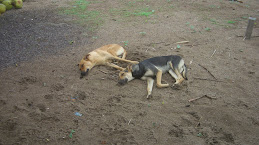



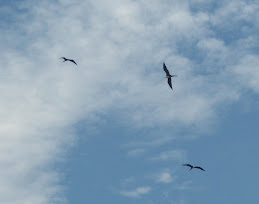


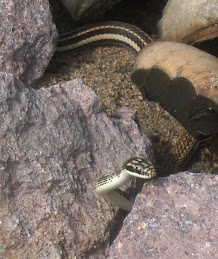
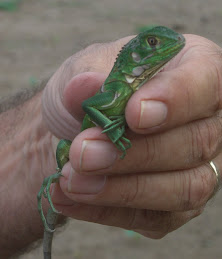
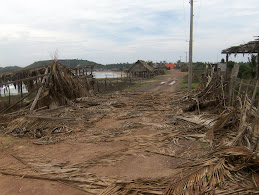
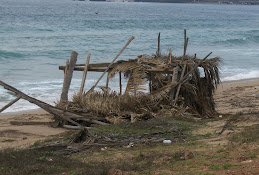



No comments:
Post a Comment